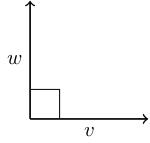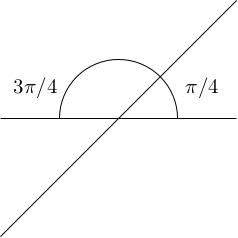The dot product is the number .
09. Dot product, 1
09. Dot product, 1
Dot product
Given two vectors and in , what is the angle between them?
To define angles in , note that the two vectors and are contained in a unique 2-plane, and we mean the usual angle between and inside that plane.

To compute that angle, we introduce the dot product .
If is the angle between and then Recall that means the length of .
We will prove this in due course, but first we'll explore it a little.
Let and . We have .

This makes sense: the angle between and is radians, and . In this case, we say the vectors are orthogonal to one another (equivalent to "perpendicular" or "at right angles").
Let and . We can see the angle between them should be 45 degrees ( radians).

Let's confirm this: we have . We also have by Pythagoras and , so so should be . Indeed, .
Even if you didn't know the angle, you could figure it out as . You might object that is multivalued, for example . This just corresponds to the fact that there are different ways of picking "the" angle between and (e.g. clockwise or anticlockwise).
